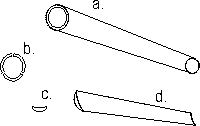This section of my web site is very, very old. You can tell, because the photos are very small. But most of the information is still correct.
Tools and Supplies
The essential elements of an oboe reed are the cane, the tube, and string. A variety of tools are used to assemble these elements and form them into a working oboe reed.
Cane

Cane (Arundo donax) is grown and harvested, mostly in southern France, then subjected to a variety of mechanical manipulations. First, the appropriate part of the plant is cut into tubes. This tube cane (a) is about 11 mm in diameter and about 75 mm in length. The tubes are split lengthwise into three pieces (b). After soaking in water for several hours, each of these pieces is placed in a gouging machine where it is shaved to a very precise and uniform cross section (c). After folding, we have a piece of gouged cane (d) as shown here.
Knives

Reed knives come in a variety of styles. Typically I use a beveled knife (a) for rough work and a hollow-ground knife (b) for fine work. I keep an old wedge knife (c) around for other tasks such as cutting string, shaping, etc. My beveled and hollow-ground knives are shown (top and bottom, respectively) in this photo.
Shaper
A shaper is a metal object formed in the shape of an oboe reed. More precisely, its lateral cross section is that of the desired cane. In the process of shaping, a piece of gouged cane is attached to the shaper and excess cane is cut away until the remaining piece precisely matches the shaper. This results in gouged, shaped, and folded cane.
Plaque & Staple
The two pieces of cane which form the double reed are attached to a metal tube called a staple. The staple has an oval opening at the top and a larger, circular opening at the bottom. The tube is 47 mm long; the lower 30 mm are covered with a cylinder of cork.
A flat strip of metal called a plaque is inserted between the two blades of the reed during scraping. The plaque adds mechanical support to the blade being scraped while protecting the other blade from harm.
String
Nylon string is used to tie cane to the staple.
Mandrel
The reed is placed on a mandrel to make it easier to hold during the scraping process. The mandrel is machined to fit precisely in the staple, so it can also be used to verify that a staple's opening is just the right shape.






